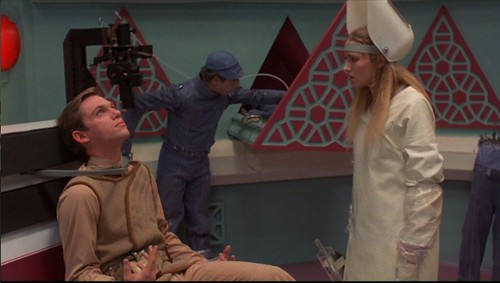He's sure taking a lot of credit for stuff he didn't do.
Andrew Probert himself chimed in in the comments section; I encourage everyone to check out his thoughts. He acknowledges the "Design credit anomalies" in Taylor's comments. Even the foul-mouthed guy (John S) -- who may very well have been involved in the original production (perhaps on the studio, Trumbull, or Apogee side -- I'm guessing the first) -- made the point that movies (particularly huge, convoluted productions like TMP) ARE made by committee. Even when the contributions of some are not scientifically or technically accurate, they may very well have artistic or practical merit (e.g. the unrealistic movement of stars, the large front window on the Travel Pod, etc.).
I love Probert's recollection of Harold Michaelson's comment, “People don’t go to the theater with a slide rule!” Man, Michaelson sure didn't know his audience did he?

That said, there were some cool photos there.
I am SO glad to see these photos again (and in such high-resolution!). The first time I saw them was at a screening a few years ago at the Egyptian in Hollywood of TMP (and a tattered, ersatz 35mm print of the SLV at that!) where Taylor did a Q&A prior to the movie. They projected most of these on the screen during the Q&A, including the unused V'ger, drydock, and docking port models.
Taylor (then and now) seems to harbor a great deal of bitterness about the whole Abel/TMP affair -- often justifiably so. The perfunctory "RA&A Designs by Richard Taylor" credit toward the VERY END of the TMP end credits roll is nothing short of insulting given the amount of his design work that ended up in the film.
He's correct about the dodecahedron modules...a bad idea all the way around.
The slides at the Egyptian screening showed much more of these. IIRC, the photo showed BOXES full of these modules, and they did look awful. Many of these photos seem to be from Abel's initial assessment of the "embarrassing" Phase II miniatures, and that particular one seemed to be Taylor's way of saying, "Look at all of this crap we'll have to throw away!" I'm guessing they did, or they would have probably turned up as a background decoration on TNG or something.
And...wow, that pic of the engine room reveals something I've never seen before!
Check out the ceiling! Look familiar?
A ladder?

Seriously though, I'm not seeing what you're seeing, but the way TMP-era stuff was repurposed into later Trek productions (sometimes MUCH later) nothing would surprise me. Is it the triangular pattern in the ceiling? It does look vaguely familiar.
EDIT: Just saw Robert Comsol's post. I'll look up the Vulcan scene; any stills from BBTS? I can so picture that production dumpster diving over at Paramount for their set decorations!
As cool as it is to see the original Engineering set, where are photos of the (supposedly color-coded) original Phase II corridor sets? I haven't seen the Phase II footage on the TNG S2 BD set; did anything show up there?
After much research from available sources, and without a definitive account of the making of TMP, my unbiased assessment is that Paramount and Trumbull were right. Abel was trying some extremely cutting-edge VFX techniques (including CGI pre-visualization of motion control work) on Paramount's dime (and absconding with the gear according to more than one account). R&D of this sort had no place in Hollywood of the day in general or the chaotic, rushed TMP production in particular, and they fell way behind schedule even without the script changes, etc. Had these innovative but half-baked VFX ended up on screen within the film's compressed production schedule, they very well might have brought to mind the VFX on TFF only 10 years earlier, paling in comparison to everything else being done by Trumbull and Dykstra at the time. As much as I prefer Abel's more literal Memory Wall concept over Trumbull's stylized "Spock Walk", I'm not convinced it would have worked based on the footage and stills available.
Abel's reach exceeded its grasp -- hardly a condemnation but the best conclusion I can reach from the available facts.

 The Vulcan floor and the "Battle Beyond the Stars" wall tiles...
The Vulcan floor and the "Battle Beyond the Stars" wall tiles...
 Seriously though, I'm not seeing what you're seeing, but the way TMP-era stuff was repurposed into later Trek productions (sometimes MUCH later) nothing would surprise me. Is it the triangular pattern in the ceiling? It does look vaguely familiar.
Seriously though, I'm not seeing what you're seeing, but the way TMP-era stuff was repurposed into later Trek productions (sometimes MUCH later) nothing would surprise me. Is it the triangular pattern in the ceiling? It does look vaguely familiar.